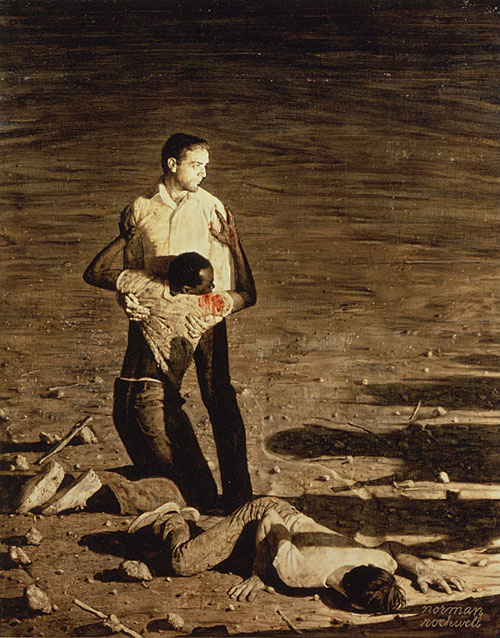

Murder in Mississippi, 1965
In the beginning of 1965, Rockwell began work on an illustration for Look about the June 21, 1964 murders of three young civil rights workers in Philadelphia, Mississippi. Michael Schwerner and his chief aide, James Chaney, were in Philadelphia to assist with training summer volunteers, one of whom was Andrew Goodman. Schwerner had been targeted by the Klan for his organization of a black boycott of white-owned businesses and for his attempts to register blacks in Meridian.
Hearing of a Klan attack against blacks and of arson at Mount Zion Church, the three men drove to the site. On their return to the Meridian office of Congress On Racial Equality (CORE), they were taken into custody by Deputy Sheriff Price, by some accounts for speeding and by others for supposedly setting the fire. After releasing them later that night, Price tailed them. Once outside of town, Klansmen intercepted them and hustled them into Price's car. They were driven to a remote location and shot point blank. Their bodies were then taken to a farm of one of the Klansmen, dumped into a dam site, and covered by tons of dirt pushed over them by tractor.
Rockwell conceived Murder in Mississippi as a horizontal composition to run across two pages. The young men would be pictured on the left page and Philadelphia Deputy Price and the posse of Klansmen wielding sticks (we later learned all were armed with rifles and shotguns) on the right. His next idea was to do two separate, vertical pictures-the first showing the civil rights workers and the second showing the Mount Zion Church. Rockwell hired local architect Tom Arienti to draft a church steeple, but later decided against including the church.
Deputy Price and his stick-wielding posse were removed and represented only by menacing shadows in this quick color sketch, the left half of the original painting. Rockwell received the go-ahead to proceed with his final painting based on this sketch but Look art director Allen Hurlburt, after receiving the final, chose to publish the sketch.
Three years later, Rockwell reflected that by the time he had finished the final painting, "all the anger that was in the sketch had gone out of it."
Murder in Mississippi (study), Norman Rockwell, 1965.
Oil on board, 15" x 12¾"
Story illustration for Look, June 29, 1965.
From the permanent collection of Norman Rockwell Museum.
Murder in Mississippi (studies, intended final, and reference material), Norman Rockwell, 1965.
Reference photos for Murder in Mississippi by Louie Lamone, 1965.